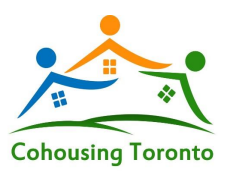About Cohousing
What is Cohousing?
Cohousing is a planned residential community or neighbourhood that combines private homes with shared indoor and outdoor spaces that are designed to support an active, interdependent and muligenerational community life. Cohousing communities typically have 8 to 40 households that share the work of developing and managing the community, buildings, and common areas through committees. This collaborative arrangement requires robust agreements about how the group works together.
What is the history of cohousing?
Cohousing began in Denmark in the 1960s, at a time when interest in options to the single- family house or apartment was growing in Europe and North America. Similar to other models of collective living, cohousing was designed to increase social connection and create a sustainable and supportive living environment. The Danes call these communities bofœllesskaber, which has been translated as “living communities.” In 1988, American architects Charles Durrett and Kathryn McCamant came up with the term “cohousing” after exploring the Danish concept. Today, there are at least 500 cohousing communities in Europe, North America, and Australia.
Learn more about cohousing
Cohousing 101: An Introduction to Cohousing
Please watch this video from Cohousing Options Canada for an introduction to cohousing, its origins and learn about communities forming here in Ontario! Find out what all-ages and 50+ cohousing looks like in Canada, the US and other parts of the world. Learn how cohousing helps address:
– The loneliness epidemic
– Co-care and support of young families and active elders
– Issues of affordability
– Social, economic and environmental sustainability
Kristopher Stevens, Cohousing Toronto member and Executive Director of Cohousing Options Canada delivers the presentation.
Cohousing 102: Taking Action, Taking Risks
Building on the content of Cohousing 101 by raising questions and considerations for those interested in the concept of cohousing.
– How do your values, sense of place and timing fit with cohousing?
– What are your hopes and fears?
– What are some of the tools you should be learning to live in cohousing?
– What are some of the risks associated with cohousing?
– Where can I find existing communities, a community to join or how to start one?
Kristopher Stevens, Cohousing Toronto member and Executive Director of Cohousing Options Canada delivers the presentation.
Non-violent communication
Nonviolent Communication ( NVC) is an approach to nonviolent living developed by Marshall Rosenberg beginning in the 1960s. NVC is based on the assumption that all human beings have capacity for compassion and empathy and that people only resort to violence or behavior harmful to others when they do not recognize more effective strategies for meeting needs. Nonviolent Communication can be seen as both a spiritual practice that helps us see our common humanity, using our power in a way that honors everyone’s needs, and a concrete set of skills which help us create life-serving families and communities. The form is simple, yet powerfully transformative. Through the practice of NVC, we can learn to clarify what we are observing, what emotions we are feeling, what values we want to live by, and what we want to ask of ourselves and others. We will no longer need to use the language of blame, judgment or domination. We can experience the deep pleasure of contributing to each others’ well being. The basics of Nonviolent Communication are quite simple really. Nonviolent Communication (NVC) helps you to create a high quality of connection out of which people spontaneously enjoy contributing to one another’s well-being.
NVC uses consciousness, language, and communication skills to create a framework from which you can:
- express your feelings and needs with clarity and self-responsibility;
- listen to others’ feelings and needs with compassion and empathy;
- facilitate mutually beneficial outcomes for all parties involved.
Sociocracy/Consensus
What is consensus decision-making?
At its most basic, consensus decision-making is an inclusive process that enables a group to arrive at a solution or decision that everyone agrees to support. The process is based on an assumption that every individual’s contribution is valuable and important to the solution or decision, and a commitment to ensuring that each individual feels that his or her ideas and concerns are heard and understood.
The process aims for all group participants to accept a decision and consent to take action on it. Consensus does not mean that every individual is going to be completely satisfied with every decision. It means that the solution or decision is acceptable enough that everyone consents to act on it. Unlike a majority vote, there is no minority that may feel that the decision has been imposed on them. This encourages shared ownership and responsibility.
Why make decisions by consensus?
A cohousing community is a community of equals. Most cohousing communities use a decision-making process that is based on consensus rather than a majority vote. The consensus process ensures that every voice is valued and heard for the benefit of the group, as well as the individual. Cohousing Toronto believes that an engaged group working and learning together generates more creative ideas, develops more successful solutions, and makes better decisions. We are actively sharing the work and the decision-making involved in building the community we want to live in. Each cohousing group defines a decision-making process to meet its own needs. Many begin with a basic consensus decision-making process and evolve to a more complex model of shared governance, such as sociocracy. Cohousing Toronto is currently using a basic consensus decision-making process, with the aim of building the skills to practise sociocracy as we grow and mature.

